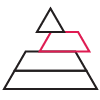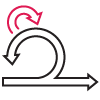Overview Over Two Hundred Years Old and Becoming Agile This company has been in the…
Case Study
SAFe® Implementation for Global, Diversified Technology Company
Company Details
Industry: Healthcare
Company Size: 100,000 employees in over 100 countries
Products: SAFe Implementation
Cprime Services:
Executive Summary
Healthcare is big business, always changing, and rapidly accelerating. Technological advancements will continue to change how patient care is delivered from the hospital to the home and points in between, and the company needed a better way to deliver value. With the help of Cprime consultants and trainers, the company underwent an Agile and SAFe transformation that resulted in improved alignment, transparency, and built-in quality.

Overview
Business Need – Keeping Pace
Healthcare business is big business, it is changing, and it is accelerating. Technological advancements are changing and will continue to change how patient care is delivered from the hospital to the home and points in between.
Problems that led to the migration to Agile for their software development projects, while not atypical, were compelling:
- Long release cycles – not keeping pace with market demands
- Indeterminate release dates due to late stage integration and test, characteristic of a process heavy waterfall software development process,
- Inability to get stakeholder feedback early and often; critical in developing complex systems in a complex domain,
- Quality and testing – complex systems require effective and incremental testing practices to validate system behavior and demonstrate compliance.
The Challenge
Transition to Scrum
In 2013 the journey toward software Agility began. Shorter time to market, fast feedback cycles, responding to changing requirements and visibility into the development process, drove the need to transition to Scrum. Scrum teams in multiple locations – California, Massachusetts, Bangalore, and Best, Netherlands teams underwent basic Scrum team training and implemented Agile-tooling support.
As teams transitioned to Scrum new roles, short sprints, Scrum ceremonies and metrics, the new process grew roots. Cultural change was starting to happen, slowly. While the waterfall thinking of long development cycles and knowing all the requirements and design details up front was fading, progress was still slow against the goals. Other problems were becoming more visible.
The Solution
The Transformation – Launching the Agile Release Trains
As with all change as progress is happening new problems arise. The teams were experiencing difficulty with geographic disperse communication and coordination, having a solid definition and prioritization of release features to be delivered in what timeframe, and lack of visibility into solution progress during the release development cycle. These are problems of scaling Agility. Addressing these problems became more acute.
The ability to execute enterprise agility led two senior program managers to investigate the Scaled Agile Framework. They became certified SAFe Program Consultants and used the SAFe Agile Release Train Launch Kit to plan and initiate the first Agile Release Train launch. The first train was a subset of the development organization and launched in September 2014.
An Agile Release Train is at the heart of the Scaled Agile Framework. An ART is a team of ScrumXP teams working on a common cadence with synchronized planning at both the sprint level and Program Increment (PI) level. The teams are aligned with a common Program level backlog of prioritized features, from which the team backlogs are derived. The teams are coordinated through four development sprints and one innovation and planning sprint at the end. These five sprints together constitute a Program Increment. The result is the teams delivering completed features every ten weeks, nominally.
The teams on the Agile Release Train meet for a face-to-face planning session to plan the four development sprints. Each team is responsible for presenting what stories will go into the development sprints and a set of Program Increment objectives. Together during the two-day session the teams identify dependencies and risks for the PI. This aspect was a major benefit. The teams were able to see potentially blocking issues, and mitigate them during planning as opposed to discovering dependency problems part way through a release cycle.
From December 2014 through May 2015 a total of three Agile Release Trains were launched and up and running on a quarterly cadence. The trains mapped to the two major product lines and one infrastructure train and encompassed the whole organization. With each planning session the teams got more and more effective in terms of teams committing to a body of work they could complete and managing the dependencies throughout the PI execution. Director of Engineering summarized “The framework has provided an explicit agreement on how to operate. With face to face planning teams are engaged and morale is high”.
The Agile transformation was dramatic. Sue Shreve, Agile Coach from Cprime, Inc. “The teams progressed much more rapidly by embracing the best practices of SAFe than they would have without. The company was open to change, had consistent management support and followed the best practices of SAFe, always. The result was success!”
The Results
Significant Speed to Market
The ability to complete key features, every quarter, was a major improvement. The shortened cycle time allowed the product and sales teams to now validate and get feedback on implementation so that when a release went into production it was addressing. They now have a customer engagement model that allows customers to see, on a predictable schedule, new features and give critical feedback. Global Director Marketing and Strategy remarked on his company’s ability to complete features, now in a timely way “We are delivering features so fast that Sales and Support is having to now keep up”.

The teams are now aligned to a common program level backlog. The Product Management team is prioritizing the features based customer demands and economic rationale, on a quarterly basis. Product Management now has a tighter coupling to their Product Owner counterparts. The face to face planning is allowing them to spot and manage dependencies much more effectively.

Because of the new Agile metrics and a very effective Scrum of Scrums team (representatives from each scrum team meeting twice a week) there is visibility and coordination between the teams. The right people make decisions tactically, in a timely way.

Building quality in through the mechanisms of Scrum and SAFe has gotten them away from a long integration cycle and defect fixing late in a release cycle.

The agile release trains are running. Synchronized planning, coordination through Scrum of Scrums, Inspect and Adapt workshops is the way it is done
On The Horizon
The company is continuing their Agile transformation. There is now a full-time internal Agile coach. There are plans to enable better in development practices such at test driven development and continuous integration. Smoothing out the bumps in the flow of value delivery is now moving upstream and downstream of the software development – a positive sign of progress.
Interested in seeing similar results in your company? Explore our flexible Scaled Agility solutions.
About Cprime
Cprime is an industry-leading, full-service global consulting firm with a focus on providing integrated and innovative solutions around digital transformation, product, cloud, and technology. With over 20 years’ experience, we provide strategic and technical expertise to businesses across more than 50 industries. Our team of advisors and technical experts have the know-how to meet organizations where they are to develop actionable solutions and solve business challenges. We also collaborate with our expansive network of partners to design, deploy, and harmonize technology stacks across organizations. Our mission is to empower visionary business leaders and teams to reimagine the future of work to achieve better outcomes.
Want to share with a colleague? Download the PDF
